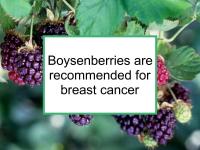Boysenberries (Rubus ursinus × R. idaeus), which were developed in the early 1920s in California, are closely related to blackberries (they are thought to be a cross between blackberry, raspberry, and, possibly, loganberry) and have similar chemopreventive properties. Boysenberries have been shown to have relatively high antioxidant content.
Boysenberries also have neuroprotective properties and can help prevent liver injury. Boysenberries are a significant source of anthocyanins such as cyanidin-3-glucoside, in addition to ellagic acid, and both soluble and insoluble dietary fiber, all of which have been shown to have chemopreventive effects. Boysenberries are also a source of salicylic acid.
Breast cancer-related effects of eating boysenberries
Boysenberries contain compounds that have been shown to have antioxidant, antiproliferative and anti-angiogenic properties. However, few studies have been performed that directly address the effect of consuming boysenberries on breast cancer. Therefore, evidence that boysenberries could be beneficial in fighting breast cancer is derived mainly from studies of related berries and berry compounds. The combination of chemicals in boysenberries may more effectively prevent cancer than any one of the component chemicals alone.
Ellagic acid
Boysenberries are an excellent source of ellagic acid—boysenberries have the highest level of ellagic acid among related berry species. Ellagic acid has been shown to reduce proliferation of hormone receptor positive (ER+/PR+) breast cancer cells. Ellagic acid has also been found to be effective in the prevention of estrogen-induced mammary tumors in rats. In fact, ellagic acid has been shown to inhibit breast cancer development in a variety of cell and animal studies, in part by inhibiting angiogenesis, the formation of new blood vessels. Angiogenesis is a crucial step that separates preinvasive and dormant forms of cancer from invasive and metastatic malignant growth.
Ellagic acid has also been found to increase the sensitivity of ER+/PR+ breast cancer cells to radiation while reducing damage to normal cells, thereby potentially enhancing the treatment effects of radiotherapy.
Anthocyanins
Berry anthocyanins have been shown to inhibit proliferation, inflammation and angiogenesis. Boysenberries are known to have high levels of anthocyanins, including cyanidin-3-glucoside, which has been shown to possess both chemopreventive and chemotherapeutic activity. For example, cyanidin-3-glucoside has been shown to reduce HER2+ cell proliferation, as well as to enhance the treatment effects of Herceptin. Cyanidin-3-glucoside also can interfere with the viability and metastatic potential of triple negative (ER-/PR-/HER2-) breast cancer cells.
Additional comments
Loganberries (Rubus × loganobaccus), which are a cross between between a blackberry and a raspberry, would also be expected to have chemopreventive activities against breast cancer.
Sources of information provided in this webpage
The information above, which is updated continually as new research becomes available, has been developed based solely on the results of academic studies. Clicking on any of the underlined terms will take you to its tag or webpage, which contain more extensive information.
Note that while we are continually searching for new evidence concerning this food, there is not much interest in it among cancer researchers, so few recent studies that include boysenberries are available.
